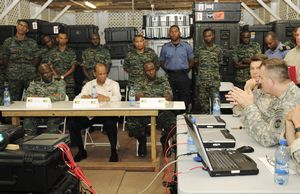 After a year of planning, members of Guyana Defense Force and U.S. military came together to train and improve their interoperability, tactics, and training techniques during Exercise Fused Response 2012, held March 1-9.
After a year of planning, members of Guyana Defense Force and U.S. military came together to train and improve their interoperability, tactics, and training techniques during Exercise Fused Response 2012, held March 1-9.
The intent of Fused Response, a U.S. Southern Command-sponsored exercise, was to build on the solid professional relationship between the two nations by improving military skills and practices to better respond to security challenges, such as transnational organized crime and illicit trafficking of humans, drugs, and other contraband.
As the executing agent for Exercise Fused Response, Special Operations Command South works with Special Operations Forces across the Caribbean, Central, and South America as part of its theater security cooperation program to establish and enhance partner nation capabilities.
The exercise lead planner, Navy Lt. Cmdr. Ron Ralls, who serves as a SOCSOUTH training and exercise officer, explained that the goal of the training event was to develop a better understanding of how the two countries’ forces operate so they can share their practices and work together seamlessly.
“It increases our ability to work with each other,” said Ralls. “It ensures that for any threat they [GDF and U.S. Forces] may go up against, they will be more efficient and better prepared.”
The exercise also allowed both nations to increase their capabilities and encouraged the exchange of ideas and techniques, which are paramount to both nations.
“Acquiring that kind of knowledge is essential in meeting an increase of threats, which we face here in Guyana,” said Col. Bruce Lovell, Colonel General Staff of GDF. “If ever we are called upon to counter or tackle any of those existing threats, we are better prepared by this type of training.”
While GDF and U.S. Forces have trained together for the past four years in similar training events, this year’s Exercise Fused Response was largest joint exercise of its kind in the Western hemisphere, involving approximately 200 GDF soldiers and 350 U.S. Forces from all branches of service.
“We have been training and doing exercises with the Guyana Defense Force for many years, but this is the first time we have had an exercise of this scope with them,” said Ralls.
Both nations’ forces, at a staff and tactical level, gained valuable experience and training working together.
“It’s been very collaborative. This is the first time we have had this type of exercise involving Special Operations Forces of the United States on such a grand scale,” said Lovell.
In preparation for the exercise, GDF and U.S. Forces have been training routinely since January in to hone and improve their military skill sets.
“It’s been a great challenge to learn some of the training tactics and techniques,” said Sgt. Cleveland O’Brien, Sergeant Major for the GDF Special Warfare School. “The U.S. has been professional, taking the time to come here and teach us, and we are grateful for everything they have taught us.”
As a Team Sergeant with GDF’s Special Warfare School, Sgt. Benjamin Hooper said by working with U.S. Forces, it has allowed the GDF Special Forces to widen their knowledge and response to any mission they could receive in the future.
“We were exposed to a lot of training, so we’ve been able to learn and accumulate a lot of different tactics,” said Hooper. “We got a clearer idea of how to conduct a mission, so in the event that something should happen in our own country, we know how to plan and execute the mission.”
“We actually get better training working with [GDF] than they do learning from us,” said U.S. Army Master Sgt. Gregory Tarancon, a noncommissioned officer-in-charge for the directorate of joint training and exercise for Special Operations Command South. “It’s a great exchange and we learn something from them every time.”
As with any exercise between two nations, there were some concerns and challenges. Along with the different levels and types of experience, GDF and U.S. Special Operations Forces had to adapt and train with each other’s equipment.
Because the GDF and U.S. military operate using different weapons and communications systems, some modifications had to be made to ensure the interoperability aspects of these tactical exercises were met.
“We had to train them on our M4’s [rifles], which were modified to shoot simulated rounds, as well as our radios so we could communicate during the exercise,” said Tarancon.
While addressing these challenges, Exercise Fused Response’s accomplished its main purpose, which was to improve the military relationships between the two partner nations.
Master Sgt. Tarancon explained that the goal of the exercise, at the strategic level, was to be able to react to a common threat and bring the different military components together to enable them to work together as a Joint Task Force.
“From what I’ve been able to see, we are way better at it [working together] than we were prior to the exercise,” he said.
From start to finish, GDF and U.S. Forces worked jointly throughout all phases of Exercise Fused Response, reinforcing the professional partnership while increasing the capabilities of both nations.
“It gives us a chance to validate ourselves and see where we are, what are our shortcomings,” said Lovell. “It [involvement] has always been conducted in an atmosphere of mutual respect, which we hold dear.”


